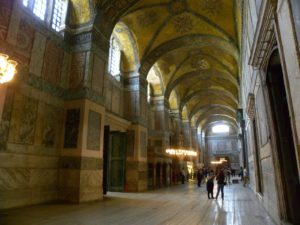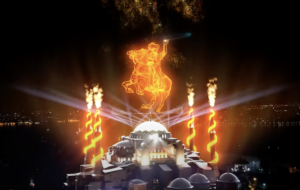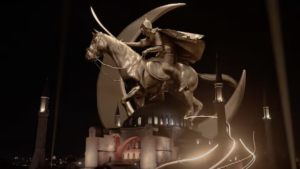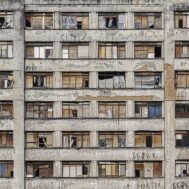
The Omphalion, located in the south-east quarter of the main square beneath the dome of Hagia Sophia.
The Hagia Sophia in Istanbul, one of the most important monuments of world heritage, is again at the center of intense global scrutiny. Turkey’s ongoing restoration project on the nearly 1,500-year-old structure is raising alarm among conservationists, historians, and human rights advocates. However, there are concerns that the work to reinforce the ancient dome against earthquakes may become part of President Recep Tayyip Erdoğan’s ideological campaign to assert a singular Islamic narrative over a monument that embodies a pluralistic past.
Once the largest cathedral in Christendom, the Hagia Sophia was built in 537 CE by Emperor Justinian I and stood as a masterpiece of Byzantine architecture and Orthodox Christianity for nearly a millennium. After the Ottoman conquest of Constantinople in 1453, Sultan Mehmet II ordered its conversion into a mosque. It was transformed into a museum in 1935 under the secular republic founded by Mustafa Kemal Atatürk—a gesture of cultural inclusivity and modernity. In 2020, Erdoğan reversed that status, designating it once more a mosque, a decision criticized worldwide for undermining Turkey’s commitment to secularism and pluralism.
Earthquake Threats

Outer hallway of Hagia Sophia. Author: Maksym Kozlenko, January 2013, Wikimedia Commons
Turkey sits atop two major fault lines, making it one of the most earthquake-prone regions in the world. This natural vulnerability becomes deadly when compounded by infrastructure weaknesses. In early 2023, two devastating earthquakes in the country’s southeast killed more than 53,000 people and leveled an area equivalent to the size of Germany—the heavy losses attributed in part to corruption and negligence in the construction sector.
In Istanbul, a metropolis of 16 million people, the risk is omnipresent. The city is dense with aging buildings and irreplaceable architectural heritage. Restoration architect Hasan Firat Diker has said that an extremely severe earthquake could crack the main arch connecting the domes and semi-domes, even send a minaret crashing into the dome or cause supporting arches to collapse altogether. After placing a structure over the dome to protect the exterior and removing the outer surfaces, the restoration team will be better able to determine what needs to be done to secure it. He also noted that scaffolding in the interior will be placed to allow the most access to visitors.
Damage from Mismanagement and Overuse

Visitor peeling strips off a painted marble wall at Hagia Sophia and collecting it in a bag. Spring 2022.
While there is little doubt that the dome’s problems need to be addressed, conservation specialists have already raised serious concerns. Since its reconversion to a mosque, Hagia Sophia has faced a deluge of foot traffic—with up to 45,000 unsupervised visitors daily—and suffered ongoing physical damage. Ancient marble floors have been broken by industrial cleaning machinery; visitors have stripped paint from walls and taken home wood chips from the ancient Emperor’s Gate as religious talismans. Social media posts and Turkish news sources have documented these acts of desecration.
Cultural heritage advocates and members of the Turkish Parliament have decried the absence of rigorous crowd control or conservation protocols that were once standard when Hagia Sophia was a museum. Former officials, including Mahir Polat of the Istanbul Municipality, have posted photographic evidence of the damage and questioned why dozens of security cameras and personnel fail to prevent vandalism. Parliamentary questions have been raised demanding accountability from the Ministry of Culture and Tourism, which has yet to offer a transparent explanation or plan.
A Politicized Restoration?

Video still of Hagia Sophia performance celebrating 569th anniversary conquest of Constantinople, May 29, 2022.
Turkish authorities describe the dome restoration as both necessary and exemplary in its use of modern engineering to counter earthquake threats. Some, however, see the restoration as offering additional opportunities for political theater reinforcing Erdoğan’s vision of a neo-Ottoman Islamic Turkey. The restoration has been described by experts, including Byzantine art historian Asnu Bilban Yalcin, as opening “a new page in the book of Hagia Sophia,” but critics suggest the page being written aims to close the book on the monument’s Christian and multi-faith past.
Statements by Erdoğan himself lend credence to this concern. In a 2022 speech, he referred to Hagia Sophia as a symbol of Turkish sovereignty and mocked contemporary Greeks as the “Byzantines plotting against us.” The use of Hagia Sophia for political symbolism is not new. But today, it accompanies a troubling pattern: the conversion of other ancient Christian churches into mosques (such as the Hagia Sophia in Iznik and Trabzon), the sidelining of Greek Orthodox leadership in Turkey, and open manipulation of education to reflect a revised religious-nationalist history.

Video still of Hagia Sophia performance celebrating 569th anniversary conquest of Constantinople, May 29, 2022.
The implications of these transformations are profound. The Hagia Sophia was long a global emblem of shared human heritage, reflecting Roman, Byzantine, and Ottoman contributions, and encompassing Orthodox, Catholic, and Muslim legacies. In its 85 years as a museum, it was a space of education, reflection, and admiration by millions, regardless of faith. Today, the monument is increasingly alienated from the global community it once welcomed.
Hagia Sophia’s grandeur lies not just in its soaring dome and luminous mosaics but in its layered history—a palimpsest of civilizations and faiths. It is hoped that this major restoration project will serve history—not revise it.
 Hagia Sophia, during its prior function as a museum. Turkey's founding father Mustafa Kemal Ataturk turned Hagia Sophia, then a mosque, into a museum in 1934. Hagia Sophia is a World Heritage site dating to the early Byzantine period, c. 537 AD and was a Christian church for 900 years. On 10 July 2020, by order of the Turkish president, Recep Tayyip Erdogan, the building again became a mosque. Photo by Mike McBey. CCA 2.0 Generic license.
Hagia Sophia, during its prior function as a museum. Turkey's founding father Mustafa Kemal Ataturk turned Hagia Sophia, then a mosque, into a museum in 1934. Hagia Sophia is a World Heritage site dating to the early Byzantine period, c. 537 AD and was a Christian church for 900 years. On 10 July 2020, by order of the Turkish president, Recep Tayyip Erdogan, the building again became a mosque. Photo by Mike McBey. CCA 2.0 Generic license. 

